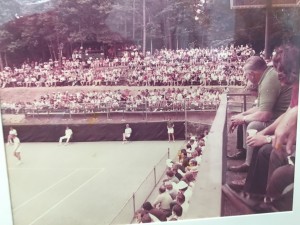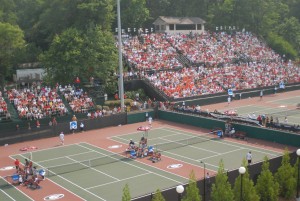By Randy Walker
@TennisPublisher
Legendary University of Georgia men’s tennis coach Dan Magill would often call Henry Feild Stadium and the University of Georgia tennis complex in Athens, Ga., as “The Mecca of College Tennis.”
The label that I would like to give these magical environs that is now named The Dan Magill Tennis Complex is “The St. Andrews of College Tennis” in reference to the legendary golf course in Scotland that is known as the home of golf.
I like this reference for two reasons.
St. Andrews is the home of golf, where the sport was played dating back to the 1500s and where the Open Championship has been played 29 times, more than any other course on the Open rotation or “rota.” Each hole of the course seeps with history where fans, media and players can recount events that have happened on almost every hole of the course, from Bobby Jones to Jack Nicklaus to Tiger Woods.
Like St. Andrews, Henry Feild Stadium has also hosted the most of its respective events – 32 NCAA Championships. It is the “home” of college tennis. Before the University of Georgia hosted the NCAA Championships for the first time in 1972, the event had barely a fan following. However, due to the promotional prowess of Magill, the 1972 NCAA Championships actually had crowds of fans – for the first time ever – as thousands of fans surrounded the courts to watch the championship unfold. Like golf fans at St. Andrews, college tennis fans, media and players in Athens can soak in the history on the courts in front of them, where John McEnroe of Stanford won the NCAA singles title as a freshman in 1978 and where Georgia’s own Mikael Pernfors won his back-to-back NCAA singles titles in 1984 and 1985 and where other famous or infamous matches and instances occurred on other courts. Other college tennis greats to win titles in Athens include Tim Mayotte in 1981, Alex O’Brien in 1992, Chris Woodruff in 1993, Bob Bryan and twin brother Mike in 1998. People can remember all the great clashes that occurred on almost every court at the complex.

There is a bit of a controversy as far as how often Georgia should host the NCAA’s, famously fomenting after the Bulldogs won its second NCAA Championship in three years in 1987 after beating a seemingly unbeatable team from the University of Southern California, who entered their semifinal match with Georgia with a 31-0 record. Some called this upset win the match that prevented Georgia from being the permanent home to the NCAA Championships. Home field advantage, some cried, was the reason why Georgia was now a new powerhouse at the NCAAs and why they were able to beat a near-unbeatable team from USC. The Georgia women’s team won its first NCAA team title in 1994, also on the home courts in Athens.
The NCAAs where then moved to other sites – first in Indian Wells, Calif., in 1990, and then to Notre Dame in 1994 and UCLA in 1997 with Athens being the host venue in between. Then College Station, Texas hosted the event in 2002 and 2005 and then Tulsa, Oklahoma in 2004, 2008 and 2016. Georgia became the host on average of about once every three years.
What was consistent with Georgia hosting the NCAAs was the huge crowd support. Crowds in excess of 5,200 (the seating capacity of the bleachers across the top three courts in the stadium) jammed in to watch NCAA tennis, including this past year. In fact, the 5,200-plus daily fans who watched the Georgia men’s team beat USC and UCLA and fall to North Carolina in the semifinals in 2017 was actually more fans than watched any single session of ATP World Tour professional men’s tennis on its “250” level in the United States in years.
The current controversy – if you want to call it that – is that the NCAA Tennis Committee recently awarded the next four NCAA Championships venues after next year’s event at Wake Forest and University of Georgia is not in that list. There will be at least a five-year stretch before Georgia next hosts the NCAAs.
For two of those six years – in 2019 and 2021 – the tournament will be played at the new USTA National Campus in the Orlando community of Lake Nona, which is not a college campus per se but it is the new home of the University of Central Florida tennis program and is one of the greatest tennis facilities in the world. The USTA National Campus in Orlando very much deserves to be a site for the NCAAs, also considering that the state of Florida is such a hotbed of tennis. It is astonishing to think that the NCAAs have not been held in the state of Florida since the University of Florida last hosted the women’s event in 2003 and the men’s event at the University of Miami way back in 1966! Oklahoma State will host in 2020 and the University of Illinois will host in 2022.
Perhaps the one element that hurt Georgia is that it only has an indoor tennis facility with four courts, which dramatically affects the championship when it rains. This was exemplified in 2017 when the weather caused havoc on the schedule causing some matches to be played 90 minutes down the road at the indoor courts at Georgia Tech in Atlanta. The men’s team tournament final had to be played indoors in the four-court Lindsey Hopkins Indoor Tennis Center. Whether it is the team tournament or during the individual tournament, the NCAA tennis committee doesn’t want to have matches potentially finishing at 2 am to run an effective and fair championship – and this has happened in the past.
The University of Georgia Athletic Department is in the middle of some major facility upgrades with its top revenue producing sport – football. A new indoor practice facility has been created for the football team and there’s also new stadium refurbishments in the works at Sanford Stadium. The university’s basketball arena is also undergoing some facility upgrades. Soon in the pecking order for these sports facility upgrades should be the expansion of the indoor center to include a minimum of six courts and potentially 12 indoor courts, as UGA Athletic Director and former Bulldog tennis letterman Greg McGarity recently hinted
This brings me to the second reason why I call Athens, Georgia “The St. Andrews of College Tennis.”
Just like the venue “rota” for the Open Championship in golf dictates that St. Andrews is the site of the tournament every five years, the University of Georgia should be the venue for NCAA tennis every three years. Write it in the books. Now. Georgia hosting the NCAAs every three years would give almost all top college players the opportunity to play an NCAA Championship in “the home college tennis.”
Ask any former college player about their college tennis career and almost all who had the chance to play in Athens will gloat about the tradition and beauty of the Dan Magill Tennis Complex. As the 2017 NCAAs came to a close in Athens, many coaches even became nostalgic, wondering when they will once again have the chance to return to make more NCAA tennis memories.
“This will be the last time we’re here for five years at least, so we need to savor this environment,” said Oklahoma coach Nick Crowell after his two players Andrew Harris and Spencer Papa won the NCAA doubles title. “There aren’t many places like this in tennis. Hopefully Georgia will get the championships back. I think it deserves to.”
Ironically, Peter Smith, the head men’s coach at USC, was perhaps the most vocal and passionate critic of Georgia not hosting the NCAAs until at least 2023.
“I’ve already voiced my displeasure to the powers that be,” he said to Chip Towers of the Atlanta Journal Constitution. “(Georgia) is the best place to host it and they should take a look at that. Atlanta’s a great tennis community and Athens, Ga., and UGA deserve the right to host it as often as possible. It’s just the best place, it’s got the best atmosphere, it’s got the best town and it has one of the best facilities in the country. It’s a shame.”
Randy Walker was a walk-on member of the 1988 and 1989 Georgia Bulldog men’s tennis team and the sports editor of the University of Georgia’s student newspaper The Red and Black in 1990 and 1991. The long-time press officer for the USTA, the U.S. Davis Cup team and the U.S. Olympic team, he is the author of the books “On This Day In Tennis History” and “The Days of Roger Federer”

